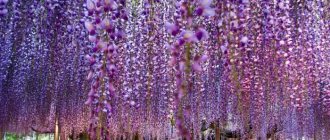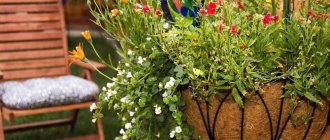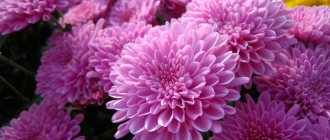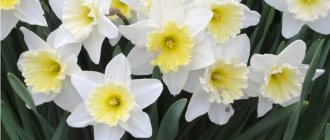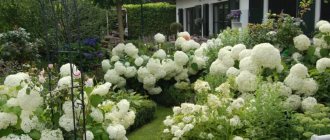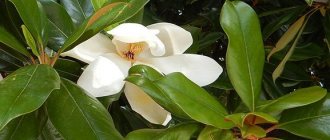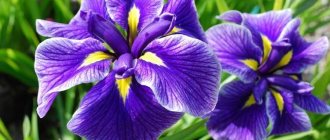Popular border flowers are annual and low-growing
Gardeners often look for low-growing varieties of border flowers that grow within one year. This is convenient from the point of view of the opportunity to change crops annually and fill the garden with new and interesting options. We suggest you focus your attention on the most popular representatives, which are especially loved by gardeners.
Beautiful annual petunia flower
Petunia is the queen of any flower bed. It has a stunning appearance and fills the garden with bright and rich colors. The main thing is to choose a good sunny place for the crop, and do not forget to water it systematically. You can grow a flower either directly into the ground or through seedlings. Refined varietal varieties are best sown through seedlings.
Bright petunia fits perfectly into the role of border plants.
To prolong the flowering of petunia, it is necessary to remove faded buds. This will allow you to enjoy not only rich flowers until autumn, but will also make the shape of the bush extremely compact.
Exquisite marigolds
These border flowers for flower beds reach a height of 0.3 meters. Marigolds (Tagetes) form bushes that produce bright flowers of yellow and orange shades. They thrive in shade and sun. It is allowed to plant marigolds both by seedlings and without seedlings.
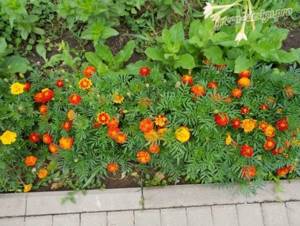
Marigolds are a great option for fall.
During flowering, the bushes look incredibly picturesque; they will delight with their beauty until the first frost. A distinctive advantage of the crops is that they are resistant to various diseases, and thanks to their specific smell, pests do not attack the bushes.
The Incredible Calceolaria
Calceolaria is an ideal low-growing flower for those who want to plant something unusual in their flowerbed. To place the bush, choose semi-shaded areas, this will guarantee abundant flowering of the plant throughout the summer. Watering is carried out extremely carefully to prevent water from getting on the leaves.
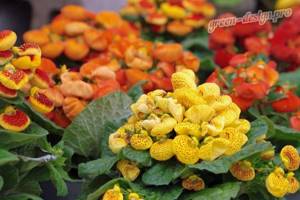
Flowers of incredible beauty and color will decorate any flower bed
It is better to grow these border flowers through seedlings. Calceolaria is placed in garden conditions at the end of May. Monitor the level of watering of the bush; do not allow it to become over-watered, as this will lead to the death of the plant.
Charming salvia
Salvia is a bush with red torch-shaped flowers. They look great in parks and courtyards. The most beautiful are considered to be salvias that have purple, cream-colored petals.
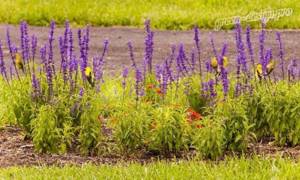
Salvia has long been a favorite of many gardeners
Propagation is usually carried out by seed method through seedlings. After planting in the garden, the crop blooms for 3 months. Looks great in composition with asters and gilly leaves.
Egyptian star pentas
Pentas are often grown as a houseplant, but in summer they can be used to form sophisticated borders by planting them in pots and arranging them in the desired order. Exquisite flowers attract many butterflies to the garden.
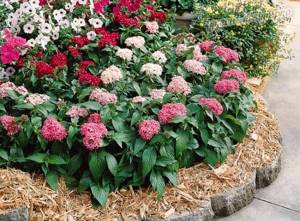
Multi-colored varieties of pentas are perfect as border flowers
The buds are distinguished by white, red, pink shades, as well as purple and lavender. The plant received the unusual name “Egyptian star” due to the visual similarity of the inflorescences to stars.
Cute pansies
Pansies or violets (Viola tricolor) are an opportunity to decorate borders in early spring. These multi-colored border flowers captivate with their variety of shades; they are found in almost all the colors of the rainbow, in several versions on one bud.

The culture feels good with plenty of light; watering is required systematically, but moderately. Among fertilizers, preference is given to mineral compositions.
Low-growing flowers for planting along paths
You can beautifully decorate small paths and paths in your dacha with the help of low-growing plants.
In total, 4 large groups of such flowers can be distinguished: ground cover, beautifully flowering, coniferous and herbaceous.
There is no need to plant everything at once. Choose one type of plant that you like best.
You can pay attention to the following plants:
- Scotch moss grows only 2-3 cm above the soil level. Loves warmth and moderate watering. You should not place it in sunny areas. Quite suitable for decorating shady paths.
- Sedum . Resistant to adverse environmental influences.
- Creeping thyme is distinguished by its early flowering (early summer) and pleasant aroma. The flowers are beautiful, pale purple.
- Loosestrife is well suited for decorating rocky paths in the country. Attracts butterflies. Used as an “edging”.
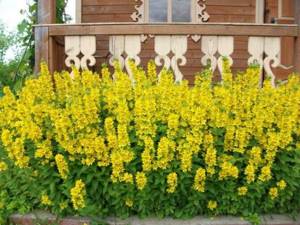
Border low-growing flowering perennial flowers
Border perennial flowers are a great way to create a border for a flowerbed or path once, without having to worry about planting crops every year. There is a huge variety of such plants to harmoniously create interesting landscape solutions. Let's focus on the most original ones.
Bright purslanes
Purslane (Portulaca) is considered an annual, but thanks to its excellent self-seeding, the plant is able to reproduce independently for several years, thereby simplifying the life of the gardener.
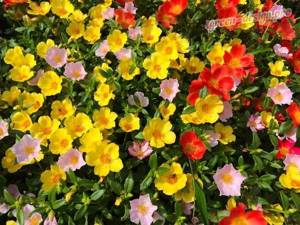
Sun-loving purslanes
Choose well-lit areas, even in direct sunlight. Weeds are not a problem when grown as the crop crowds out other plants around. Minimal watering is required, only during periods of severe drought.
Beautiful border perennial - nemophila
Nemophila is a low-growing border perennial that can reach a height of up to 0.25 meters. The bush is distinguished by its beautiful flowering, openwork leaves with an original pattern along the edges.
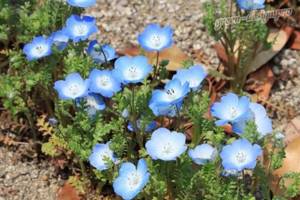
The long flowering period of Nemophila will be an important criterion when choosing border plants
Flowering duration is throughout the summer. It is not afraid of lower temperatures, so it does not need shelter for the winter.
Refined lilies of the valley
May lily of the valley (Convallaria majalis) is a low-growing perennial flower with snow-white bells and wide elliptical leaves. They look great framed by miniature flower beds and ridges.
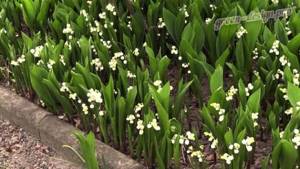
Plant care is kept to a minimum - it is necessary to regularly water the lily of the valley, especially during periods of drought, and also systematically remove weeds.
Fairytale aubrieta
This is a carpet plant that is ideal for planting in rock gardens. It is used both for decorating flower beds and for self-cultivation. Flowering lasts 1.5 months, starting in May and ending in July.
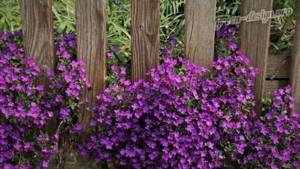
Few people will remain indifferent to this beautiful ground cover flower - aubrieta
Caring for a shaving is not difficult. The main thing is to water during dry periods using the sprinkling method. After watering, the soil is loosened and weeds are eliminated. Also, do not forget about pruning the bush so that the bush grows new shoots.
Suitable plant varieties
Now let's take a look at the low-growing perennial border flowers that will become a worthy decoration for your site. These plants allow the grass part to die during the period when frosts arrive, but retain the root system, which falls asleep until the end of the cold season. At the beginning of spring, such flowers awaken, new shoots and flowering appear.
One example of a plant with such properties is chives or skoroda. This flower belongs to the bulbous plants. During the flowering period (late spring - early summer), a lush inflorescence of a delicate pink or purple hue appears at its top.
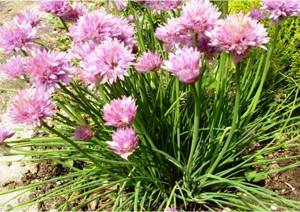
The next suitable variety is Arabis. This flower is honey-bearing and during the flowering period it blooms in the form of snow-white, red, pink, purple flowers (depending on the chosen variety). They can be seen from May to June.
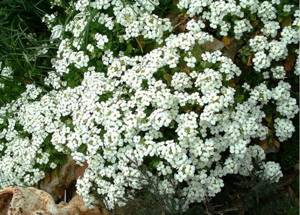
You can choose border flowers such as gravilate. In addition to the beautiful flowering that occurs in late spring, it is also characterized by medicinal properties. Gravilata flowers look like small open buds of orange, yellow, red or pink.
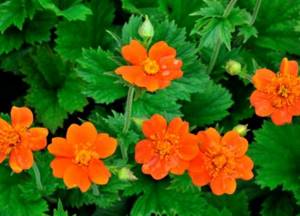
Sedums are popular in flower beds and gardens. These plants love light and are able to maintain their appearance and health only with slight shading.
But in the shade the plant quickly fades and deteriorates, and can also change shape. Most varieties of this plant bloom in July and have pinkish or yellow flowers.
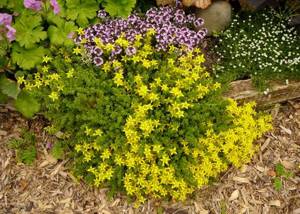
Unpretentious border perennials include tenacious ones. It covers the soil with a kind of carpet and is resistant to temperature, moisture and light. This plant can change its color depending on the season and climate.
Vertical blue inflorescences of the tenacious can be seen in May or summer.
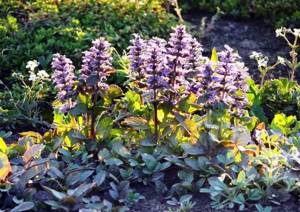
And if you like daisies, you'll probably appreciate feverfew, as it has a similar bloom pattern in the summer. Refers to unpretentious and cold-resistant varieties.
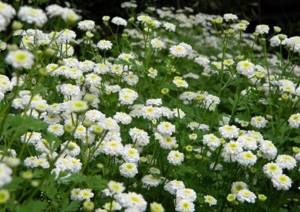
We also advise you to pay attention to perennial border shrubs, for example, alpine aster, which can grow up to thirty centimeters. The flowers of this aster variety have a yellow core and pinkish or blue petals. Prefers light or partial shade and blooms during June and July.
In winter, it is not necessary to cover such flowers, since they can easily tolerate the cold.
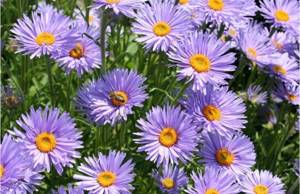
Perennial hosta is also suitable for decorating border areas. This plant is generally quite popular in landscape design, because even when it does not bloom, it attracts attention with its wide leaves of dark and light green shades. And some varieties of hosta also have bright foliage.
During the flowering period (from mid to late summer), inflorescences appear on the hostas in the form of brushes of snow-white, purple and hot pink shades. The height of the stems is about thirty centimeters.
Hosta has excellent resistance to frost, but requires constant watering during periods of high temperatures.
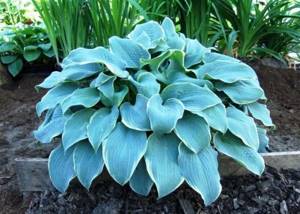
The border chrysanthemum has a small height (up to thirty centimeters). The flowers of this plant have different shades and bloom in mid-summer. You can enjoy the bright blooms of chrysanthemums before frost arrives. This variety performs best when planted in full sun.
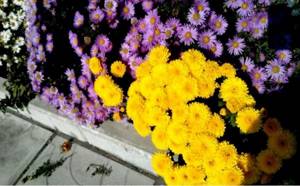
If you love roses, you can choose a small variety “Debut” for your plot, up to 38 centimeters high. These roses are dark red in color and bloom profusely from June to September. In the winter season, young bushes should be covered with spruce branches or film.
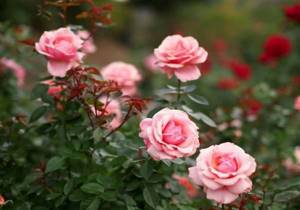
Here are a few more suitable low-growing perennial border flowers:
- bulbous varieties - galanthus, tulip, pushkinia, muscari;
- ground cover plants – periwinkle, phlox;
- low-growing herbaceous plants - bergenia, jagged lavender, primrose;
- low-growing shrubs - lingonberries, dwarf barberries and others.
If you need to fill an area in the shade with flowering vegetation, choose astilbe, irises, brunnera, hellebore and other plants adapted to the lack of sunlight.
Blue border flowers
It often happens that gardeners have the specific goal of finding border flowers of a certain shade. This is necessary to form and frame visually attractive flower beds. We offer three of the most interesting representatives of the floristic family, with bluish or blue petals.
Exquisite ageratum
Ageratum can be grown both as a perennial and as an annual (depending on the climatic conditions of the region). It is distinguished by unusually beautiful buds that add brightness to any area. The plant requires systematic watering, as well as the application of fertilizers, then it will give abundant flowering.
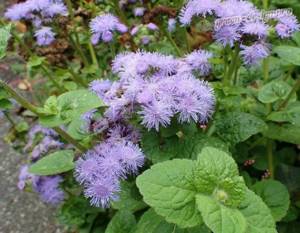
Perennial ageratum in a flowerbed
Ageratum prefers mineral supplements, as well as diluted mullein. For long-term flowering, you will need to systematically remove faded inflorescences.
Bright survivor
Tenacious (Ajuga) is a perennial or annual that can reach a height of up to 0.5 meters. To grow a crop, it must be systematically watered. Until the leaves form on the bushes, do not allow ultraviolet rays to reach the survivor.
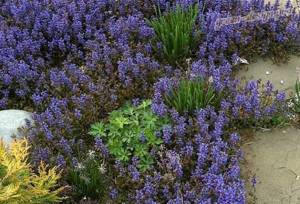
The bush develops quickly, so fence off the area where it is planted with pebbles. Remember to remove flowers that have already faded, as this will prolong flowering.
African Lily Agapanthus
Agapanthus prefers sunny areas. It is not demanding on the composition of the soil, but it develops better in nutritious and moist soils. As a maintenance procedure, gardeners recommend systematically fertilizing the plant. For this, mullein or chicken droppings are used.
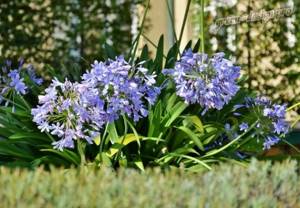
Charming border flower - agapanthus
For the winter season, the African lily will need to be dug up and stored in the basement.
Red border flowers
Unpretentious red garden border flowers are an ideal solution for plain, dim flower beds. We offer several interesting solutions for your own garden.
Incredible gravilate
Gravilat (Geum) is distinguished by rather large flowers that are very attractive to bees. In addition to its decorative properties, the culture is also distinguished by its medicinal characteristics.
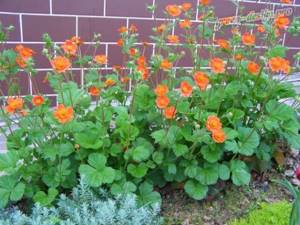
The rules for caring for gravel are the systematic removal of weeds and periodic loosening of the soil. Additionally, you will need to remove dry flower stalks, feed and water the bushes.
Exquisite red pyrethrum
Pyrethrum comes in different shades, but red is the brightest and most attractive. The height of the bush is up to 0.7 meters, but there are also low representatives - up to 0.4 meters.
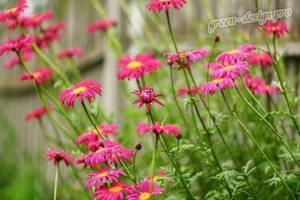
Caring for pyrethrum consists of moderate watering, fertilizing with organic matter and minerals.
Stylish balsams
Impatiens is a low-growing border plant that blooms for a long time. It can bloom in different shades, pink and red being the most popular. The maximum height of the bushes is up to 0.5 meters. Fleshy leaves only add originality to balsam. Impatiens grows in different areas, both with good lighting and in the shade.
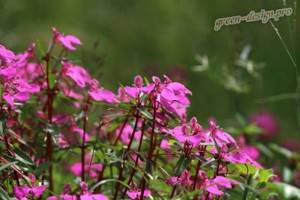
Photo of balsam
The crop needs timely watering; it is moisture-loving. It is fed every 2 weeks, for this purpose mineral compounds are used.
Low-growing hedges that need trimming
Boxwood
The most popular shrub that is great for creating living borders is boxwood. It makes low and very beautiful frames for flower beds; with its help it is good to zone the space of a site. In addition, from boxwood alone you can form unusual compositions that will look no worse than the flower garden itself. Boxwood lends itself well to pruning and is easily restored.
Golden currant
We are used to the fact that currants are a berry bush. But it’s time to look at it with different eyes, because this plant can become a real decoration of the garden if you choose a decorative variety and form a hedge. The currant bush itself is quite tall, but if you prune it in a timely manner, you can get a hedge as tall as you need.
Cotoneaster brilliant
Another great plant for a hedge or border is cotoneaster. It is good because it grows slowly and has a fairly dense crown. At different times, it is first decorated with small white or pink flowers, and then with conditionally edible black berries. Cotoneaster is unpretentious, relatively frost-resistant and tolerates drought well, so growing it is a pleasure.
Thuja occidentalis
This plant cannot be called a dwarf, but if it is formed correctly, then the western thuja will make an excellent low hedge. Thanks to its dense and dense greenery, the crop is ideal for planting along the contour of the site. In the garden you can use it to make low frames for individual trees or flower beds. And some summer residents manage to form various figures from thuja occidentalis. The tree tolerates shaping shearing well.
Sophisticated white border flowers
Creating a perennial snow-white border is a stylish solution that will make your area delicate and sophisticated. We present a list of the most beautiful perennials for borders that have white petals.
Campanula White Pouffe
Campanula White Pouffe or bells is a sophisticated, beautiful plant with snow-white petals. Requires systematic watering; the earthen clod is not allowed to dry out. Usually the plant is planted in pots, which are then harmoniously installed in the required places.
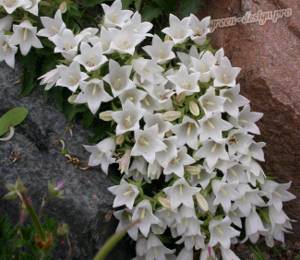
Snow-white bells or campanula
Campanula needs fertilizing, which is carried out once every 14 days. For this, it is preferable to use mineral compositions.
Unpretentious hosta
Hosta is an attractive plant with rich green leaves and bright white flowers. When planted in nutrient soil, the crop does not even have to be fed. But on poor soils, the application of liquid compounds will be required.

Hosta enchants not only with its white flowers but also with its unique foliage.
It is necessary to water the hosts periodically to ensure that the bush has an attractive appearance. You will also need to loosen the soil, but only at the beginning of cultivation. After 3-4 years, the bushes take root.
Tender Iberis
Iberis is an incredibly beautiful perennial or annual that is distinguished by rich green leaves, as well as sophisticated purple or white flowers. The height of the bush is up to 0.35 meters.
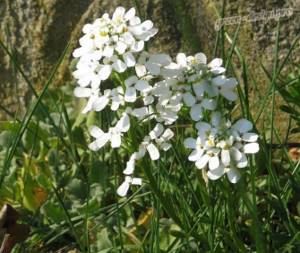
Refined Iberis
It propagates vegetatively, but the seed method is also suitable for such purposes. Iberis prefer lighted places with good, fertile soil. Care consists of fertilizing, which is carried out twice a season, using mineral compounds.
Properly selected border flowers will provide an excellent opportunity to decorate flower beds, paths or other garden compositions with unusual crops.
